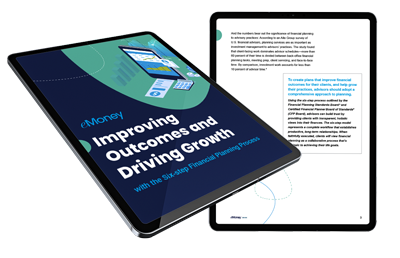
for expert insights on the most pressing topics financial professionals are facing today.
Learn MoreYou’ve put it off long enough. Time to get that “Check Engine” light examined by the mechanic. You’ve gotten a flat tire here and there, and that knocking noise in the engine comes and goes. But surely your car is fine and will run smoothly for years to come.
Like trusted mechanics, financial advisors hold a uniquely important place in their clients’ lives. They can build a trusting relationship, examine accounts and spending habits, and make recommendations for better financial performance. By adopting a six-step financial planning process (recommended by the CFP Board and FPSB) you can set your customers on smoother path. But if a client doesn’t have confidence in your abilities or decides not to follow your instructions, that beautiful sports car could be headed for the junkyard.

There’s no wrench or jack involved, but asking a customer to reveal their financial situation can be as unnerving as watching your mechanic pop the hood for the first time. What will they find under there?
Clients need to trust that you are knowledgeable. What advice do they need to achieve their financial goals? It could be small adjustments in their spending habits or a total financial overhaul. Your client needs to trust your recommendation for a new transmission, when they expected a routine oil change.
Consumers have countless options for investing and planning. They choose to work with you because they’re confident in your abilities.
Asking Grandpa to listen to the strange noise your engine is making is vastly different from taking your car to the established mechanic with years of strong reviews. As you’re collecting pertinent information, a digital-first approach can save you and your client valuable time and effort.

Your mechanic emerges from under the car and lets out a whistle. Is everything in working order? Or should you have been filling up the gas tank with 93 octane all these years?
Advisors need to look at the total picture to make realistic recommendations. Here’s where your customers’ confidence in you really matters. They need to know you understand what you see.
“Well, there’s good news and bad news.” Does any statement inspire such a contradictory reaction? The bad news: Your car needs quite a bit of work (grimace). The good news: It can be fixed quickly and affordably (whew!).
True change begins with developing recommendations and presenting them to the client. Your customer has learned to trust your expertise, watched you thoroughly examine their financial picture, and eagerly awaited your guidance. For a better chance of adoption, the recommendations should balance the real with the ideal, and allow the client to keep their options open.

Map out a realistic path forward. Remember those nagging thoughts you had about using better quality gasoline? It wasn’t just marketing hype. Now you know what you need to do for the future. Clear instructions can keep your car on the road for a few more years.
As an advisor, you may be equipped to implement all your recommendations. Or you might refer clients to a trusted network of professionals like a CPA, attorney, or insurance agent. Assigned actions need to be clear and carry manageable timelines.
Does your mechanic send you a postcard every six months, reminding you the car is due for a tune-up? There’s a reason these arrive year after year. The shop knows that regular follow up and communication ensures a better chance of you following their recommendations.
Your client may prefer frequent in-person communication, or an annual phone call to make sure things are progressing as anticipated. No matter what you and your customer agree on, it’s important to keep that line of communication open and the feedback loop strong.
By now your client’s financial future, like their dream car, should be humming along beautifully. Following these six steps can keep your customer on the road to making fewer pit stops and more cruising in the fast lane.
